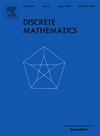F2F2[u2]F2[u3]-additive cyclic codes are asymptotically good
IF 0.7
3区 数学
Q2 MATHEMATICS
引用次数: 0
Abstract
In this paper, we construct a class of -additive cyclic codes generated by 3-tuples of polynomials, where is the binary field, () and (). We provide their algebraic structure and show that generator matrices can be obtained for all codes of this class. Using a random Bernoulli variable, we investigate the asymptotic properties in this class of codes. Furthermore, let be a real number and and t be pairwise co-prime positive odd integers such that the entropy at is less than , we prove that the relative minimum homogeneous distances converge to δ, and the rates of the random codes converge to . Consequently, -additive cyclic codes are asymptotically good.
F2F2[u2]F2[u3]-加性循环码是渐近好的
本文构建了一类由三元组多项式生成的 F2F2[u2]F2[u3]- 附加循环码,其中 F2 是二元域,F2[u2]=F2+uF2 (u2=0) 和 F2[u3]=F2+uF2+u2F2 (u3=0) 。我们提供了它们的代数结构,并证明可以得到该类所有编码的生成矩阵。利用随机伯努利变量,我们研究了这一类码的渐近特性。此外,设 0<δ<1 为实数,k、l 和 t 为一对同素正奇数整数,使得 (k+l+t)δ3 处的熵小于 23,我们证明了相对最小同质距离收敛于 δ,随机码的速率收敛于 1k+l+t。因此,F2F2[u2]F2[u3]-附加循环码是渐近良好的。
本文章由计算机程序翻译,如有差异,请以英文原文为准。
求助全文
约1分钟内获得全文
求助全文
来源期刊

Discrete Mathematics
数学-数学
CiteScore
1.50
自引率
12.50%
发文量
424
审稿时长
6 months
期刊介绍:
Discrete Mathematics provides a common forum for significant research in many areas of discrete mathematics and combinatorics. Among the fields covered by Discrete Mathematics are graph and hypergraph theory, enumeration, coding theory, block designs, the combinatorics of partially ordered sets, extremal set theory, matroid theory, algebraic combinatorics, discrete geometry, matrices, and discrete probability theory.
Items in the journal include research articles (Contributions or Notes, depending on length) and survey/expository articles (Perspectives). Efforts are made to process the submission of Notes (short articles) quickly. The Perspectives section features expository articles accessible to a broad audience that cast new light or present unifying points of view on well-known or insufficiently-known topics.
 求助内容:
求助内容: 应助结果提醒方式:
应助结果提醒方式:


